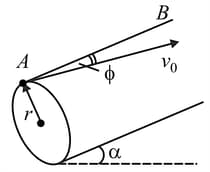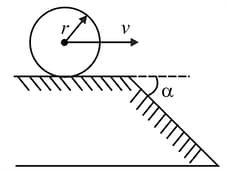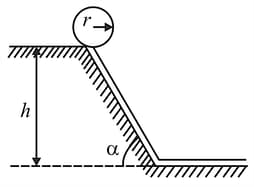Several identical balls are at rest in a smooth stationary horizontal circular pipe. One of the balls explodes, disintegrating into two fragments of different masses.
Determine the final velocity of the body formed as a result of all collisions, assuming that the collisions are perfectly inelastic.

Important Questions on Mechanics
Three small bodies with the mass ratio (the mass of the lightest body is ) are kept at three different points on the inner surface of a smooth hemispherical cup of radius . The cup is fixed at its lowest point on a horizontal surface. At a certain instant, the bodies are released.
Determine the maximum amount of heat that can be liberated in such a system. At what initial arrangement of the bodies will the amount of liberated heat be maximum? Assume that collisions are perfectly inelastic.
A long smooth cylindrical pipe of radius is tilted at an angle to the horizontal. A small body at point is pushed upwards along the inner surface of the pipe so that the direction of its initial velocity forms an angle with generatrix . Determine the minimum initial velocity at which the body starts moving upwards without being separated from the surface of the pipe.

An inextensible rope tied to the axle of a wheel of mass and radius is pulled in the horizontal direction in the plane of the wheel. The wheel rolls without jumping over a grid consisting of parallel horizontal rods arranged at a distance $l$ from one another .
Determine the average tension of the rope at which the wheel moves at a constant velocity , assuming the mass of the wheel to be concentrated at its axle.
Two coupled wheels (i.e. light wheels of radius fixed to a thin heavy axle) roll without slipping at a velocity perpendicular to the boundary over a rough horizontal plane changing into an inclined plane of slope . Determine the value of at which the coupled wheels roll from the horizontal to the inclined plane without being separated from the surface.

A thin rim of mass and radius rolls down an inclined plane of slope , winding thereby a thin ribbon of linear density figure. At the initial moment, the rim is at a height above the horizontal surface. Determine the distance, from the foot of the inclined plane at which the rim stops, assuming that the inclined plane smoothly changes into the horizontal plane.

Two small balls of the same size and of mass and are tied by a thin weightless thread and dropped from a balloon.
Determine the tension of the thread during the flight after the motion of the balls has become steady-state.
